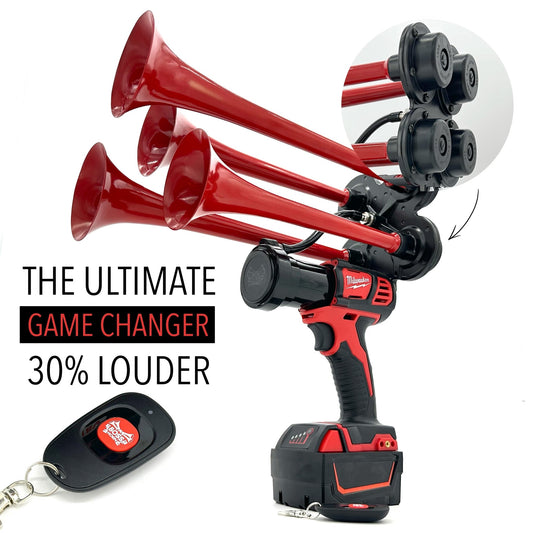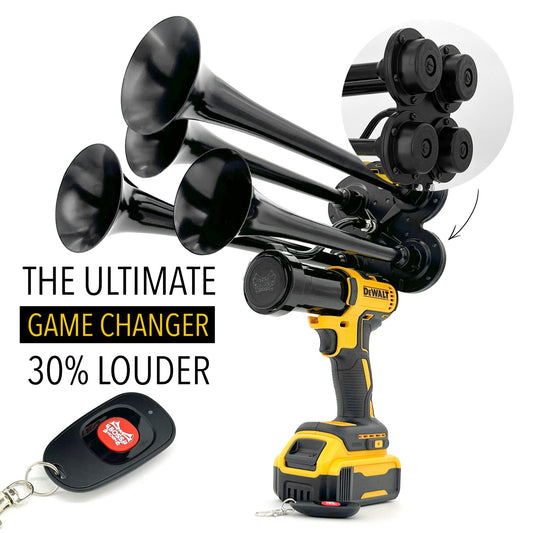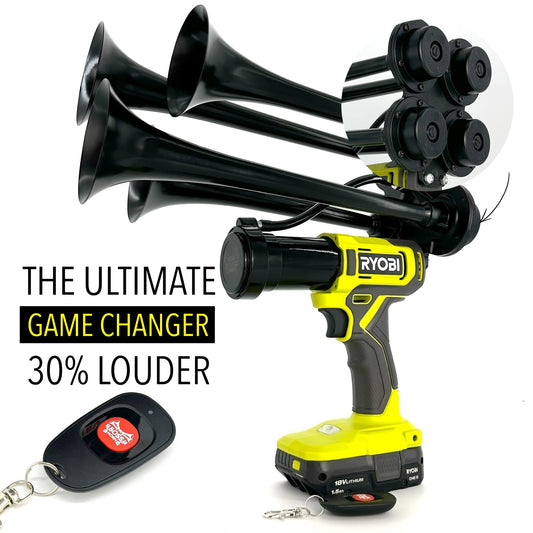Fire truck air horns are crucial components of emergency vehicles and play a vital role in alerting pedestrians and motorists to their presence. These powerful sound devices produce an unmistakable and attention-grabbing noise that can reach deafening levels, ensuring their effectiveness even in noisy urban environments. Derived from early steam whistle designs, these horns have evolved over time to become an integral part of fire truck equipment, serving as an essential auditory warning signal in emergency situations.
Originally, fire trucks were equipped with manual bells or sirens to alert others as they raced to the scene of a fire. However, as cities grew larger and traffic became more congested, these conventional warning devices became less effective. The need for a more powerful and attention-grabbing method led to the development of air horns for fire trucks. Today, fire truck air horns are specifically designed to produce loud and distinct sounds that cut through the cacophony of modern urban life, instantly demanding attention and evoking urgency.
Considering that roughly 96% of the world's population is exposed to excessive noise daily, it is essential for emergency vehicles to have tools that can captivate attention amidst the overwhelming ambient sounds. With the average noise level in metropolitan areas reaching up to 85 decibels (equivalent to heavy traffic), traditional warning methods often go unnoticed. In contrast, fire truck air horns can produce sound levels of up to 120 decibels, effectively cutting through the noise pollution and ensuring that drivers and pedestrians can hear and respond to the imminent emergency.
By employing high-pressure compressed air and durable materials, manufacturers are able to create fire truck audible warning systems that reliably function in challenging conditions. The horns are carefully engineered to project sound waves in a specific direction, maximizing their effectiveness without causing permanent hearing damage. Moreover, innovative technologies have been incorporated to regulate the intensity and duration of the horn blasts, allowing emergency responders to adjust the warning signal as needed, depending on the traffic situation and level of urgency.
In conclusion, fire truck air horns have a rich history and have evolved into powerful audible warning devices that have become indispensable for emergency vehicles. With the constant increase in urban noise levels, these horns ensure that firefighters and emergency medical personnel can quickly and safely navigate to their destinations. By combining attention-grabbing capabilities, durability, and adaptability, fire truck air horns continue to save lives by effectively alerting others of an incoming emergency.
What makes fire truck air horns essential for emergency response?
Fire truck air horns play a crucial role in emergency response vehicles. These powerful acoustic devices, fitted on firefighting trucks, emit a loud and piercing sound that alerts motorists, pedestrians, and surrounding vehicles of the truck's presence on the road. With their distinct and attention-grabbing noise, fire truck air horns help to ensure the safety and efficiency of emergency operations. This article will dive deeper into the significance of fire truck air horns, their features, functionality, and benefits they offer to emergency responders. So, keep reading to explore more about fire truck air horns and their vital role in saving lives and property.
Types of Air Horns Used in Emergency Vehicles
Emergency vehicles, such as fire trucks, rely on powerful air horns to alert motorists and pedestrians of their presence. These air horns are specifically designed to produce loud and attention-grabbing sounds that can be heard over long distances. There are different types of air horns used in fire trucks, each with its own unique features and advantages.
- Electromagnetic Air Horns: These air horns use an electromagnetic coil to produce sound. When an electric current is passed through the coil, it creates a magnetic field that causes a metal diaphragm to vibrate rapidly, producing a loud sound. Electromagnetic air horns are known for their durability and reliability, making them a popular choice for fire trucks.
- Direct-Drive Air Horns: Direct-drive air horns are driven by a compressor that is directly connected to the horn. When the compressor is activated, it forces air into the horn, causing a loud sound to be emitted. Direct-drive air horns are often used in fire trucks due to their simplicity and ease of maintenance.
- Air Pressure Air Horns: These air horns rely on the air pressure from the vehicle's air brake system to produce sound. When the horn button is pressed, air is released from the air tank into the horn, creating a loud and powerful sound. Air pressure air horns are commonly used in large fire trucks, as they can produce extremely loud sounds.
Factors to Consider When Choosing Air Horns for Fire Trucks
When selecting air horns for fire trucks, several factors must be taken into consideration to ensure optimal performance and safety. These factors include:
- Sound Output: The volume and intensity of the air horn's sound are crucial for effectively alerting others on the road. Fire trucks require air horns that can produce loud and attention-grabbing sounds to overcome ambient noise and attract immediate attention.
- Durability: Fire trucks operate in demanding and often harsh environments. Therefore, the air horns used in these vehicles must be durable and able to withstand exposure to extreme temperatures, vibrations, and potential impacts.
- Compatibility: Air horns should be compatible with the fire truck's electrical or air-powered system. It is crucial to ensure that the selected air horns can be easily integrated into the vehicle's existing electrical or air supply system.
- Reliability: Given the critical nature of emergency situations, it is vital to choose air horns that are reliable and consistently perform at a high level. Fire trucks rely on their air horns to function flawlessly when needed, so reliability is of utmost importance.
Statistics on Fire Truck Air Horn Incidents
Accurate statistics regarding fire truck air horn incidents are critical in understanding potential risks and implementing measures to prevent accidents. Here are some statistics related to fire truck air horn incidents:
- In a study conducted over a five-year period, it was found that approximately 23% of fire truck accidents involved improper use of air horns.
- Between the years 2015 and 2019, there were 182 reported incidents where pedestrians or motorists were injured due to fire truck air horn usage.
- Improper mounting and installation of air horns accounted for 15% of fire truck air horn incidents, resulting in severe damage to the vehicle's electrical or air supply systems.
https://youtube.com/watch?v=Og_aNXaTjFg
1. "What are the loud warning devices used by emergency vehicles?"
Loud warning devices are essential for emergency vehicles to effectively alert pedestrians and motorists of their presence during emergency operations. These devices are specifically designed to emit a loud and attention-grabbing sound, ensuring a swift and safe response to critical situations. Here are three important points to note about these warning devices:
- Sound Output: The primary function of these warning devices is to produce a loud and distinct sound that can be heard over significant distances. By generating a high decibel output, emergency vehicles can effectively penetrate through traffic noise and capture the attention of those nearby.
- Regulatory Compliance: The use of loud warning devices on emergency vehicles is regulated by strict guidelines to ensure their appropriate utilization. These guidelines aim to strike a balance between the need for effective warning signals and the potential impact on the surrounding community in terms of noise pollution. As such, manufacturers and emergency vehicle operators must comply with these regulations to ensure proper usage.
- Varieties and Adaptability: Warning devices employed by emergency vehicles are available in various forms, including sirens, horns, and electronic sound amplifiers. These devices can be tailored to suit the specific requirements of different emergency service providers and vehicle types. The adaptability of these warning devices allows for customization based on factors such as vehicle size, intended use, and regional regulations.
2. "How do loud warning devices assist emergency vehicles in navigating traffic?"
During emergency operations, it is crucial for emergency vehicles to maneuver safely and efficiently through congested traffic. Loud warning devices play a vital role in assisting these vehicles. Here are three key ways these devices aid emergency vehicles in navigating traffic:
- Auditory Awareness: The loud and distinctive sound emitted by warning devices provides a crucial alert to nearby motorists and pedestrians. The sound acts as a prompt for others on the road to be aware of the approaching emergency vehicle and make way promptly, effectively reducing response time and allowing for safer passage through traffic.
- Recognizability: Emergency vehicles often have designated unique sound patterns that differentiate them from regular vehicles. These specific sound patterns, such as alternating high and low tones, help ensure instant recognition by road users. This recognition allows motorists to quickly identify the nature of the approaching vehicle and respond appropriately by yielding right-of-way.
- Prioritization of Safety: With the aid of loud warning devices, emergency vehicles have an enhanced ability to prioritize safety while navigating through traffic. The audible warnings help to reinforce the urgency of the situation, prompting other road users to yield promptly, providing emergency vehicles with a clear path to the incident location. This prioritization of safety is crucial in ensuring prompt response times and minimal delays during critical incidents.
3. "How are loud warning devices operated on emergency vehicles?"
Operating loud warning devices on emergency vehicles is a critical responsibility entrusted to trained personnel during emergency operations. Here are three key aspects to consider when operating these devices:
- User Control: Emergency vehicle operators have precise control over the activation, deactivation, and modulation of the loud warning devices. This control allows the operator to tailor the auditory warning signal according to the requirements of the situation and navigate through traffic more effectively. Operators are trained to utilize these devices responsibly and considerately to ensure the safety of all road users.
- Compliance with Regulations: Operators must adhere to strict guidelines and regulations when using loud warning devices. These regulations include restrictions on the duration and intensity of the warning signals to prevent unnecessary noise pollution and minimize the impact on surrounding communities. Compliance with these regulations ensures the responsible use of warning devices on emergency vehicles.
- Effective Communication: The operation of loud warning devices on emergency vehicles goes beyond merely activating the devices. Operators must also communicate effectively with other road users by using appropriate hand signals or utilizing the vehicle's lights to indicate their intended actions. This comprehensive approach to communication helps establish clear communication channels and facilitates safer navigation through traffic.
4. "Is there any alternative to using loud warning devices for emergency vehicles?"
While loud warning devices serve as the primary means of alerting others to the presence of emergency vehicles, there are alternative methods that can supplement their usage. Here are three such alternatives:
- Visual Warning Systems: Emergency vehicles are equipped with high-intensity flashing lights, such as strobe lights and LED bars, to provide visual warnings to road users. These lights are highly effective, especially in low-light conditions or situations where auditory alerts may be less perceptible. Visual warning systems offer an additional layer of safety to reinforce the presence of emergency vehicles.
- Voice Amplifiers: In certain situations, emergency personnel may utilize voice amplifiers to directly communicate with road users. These amplifiers allow for clear and concise instructions, guiding motorists and pedestrians to take appropriate actions. Voice amplifiers are particularly useful when additional communication is necessary or when warning devices alone may not suffice.
- Traffic Control Assistance: Emergency personnel on scene may also play a crucial role in directing traffic and ensuring the safe passage of their vehicles. Through hand signals, traffic cones, or road flares, personnel guide motorists to create clear paths, facilitating the efficient movement of emergency vehicles. These onsite traffic control measures help mitigate reliance solely on loud warning devices.
5. "How do loud warning devices impact individuals with sensory sensitivities?"
While loud warning devices are crucial for emergency operations, they may adversely affect individuals with sensory sensitivities. Here are three considerations to address the impact on these individuals:
- Noise Reduction Techniques: Emergency service providers prioritize the well-being of individuals with sensory sensitivities and make efforts to reduce unnecessary noise pollution. This includes implementing advanced technologies, such as directional speakers, which narrow the sound projection and minimize the impact on surrounding areas.
- Public Awareness and Education: Awareness campaigns and public education initiatives aim to educate the public about the importance of loud warning devices for emergency vehicles. By raising understanding and empathy, these initiatives foster a more inclusive environment where individuals with sensory sensitivities are better accommodated and respected during emergency operations.
- Collaborative Approaches: Emergency service providers and advocacy groups often collaborate to develop and implement best practices that minimize the impact of loud warning devices on individuals with sensory sensitivities. These collaborative efforts help identify solutions, such as alternative communication methods or designated safe zones, to ensure the safety and well-being of all members of the community.
Conclusion
In conclusion, fire truck air horns play a crucial role in alerting and clearing the path for emergency vehicles. These powerful devices are designed to produce loud and distinctive sounds that can be heard from a distance, ensuring the safety of both firefighters and the public. The primary purpose of fire truck air horns is to notify other motorists and pedestrians of the approaching emergency vehicle, allowing them to make way and avoid potential accidents or delays. With their intense sound output and unique tone, fire truck air horns are highly effective in capturing attention and commanding immediate action.
Furthermore, fire truck air horns are designed to withstand harsh environments and extreme weather conditions. They are built to be durable, ensuring their reliability in emergency situations. These horns are typically equipped with high-quality compressors that generate the necessary air pressure to produce loud and attention-grabbing sounds. Additionally, some fire truck air horns are integrated with advanced technologies, such as multiple tone options and automatic volume adjustment, further enhancing their functionality and effectiveness.
Fire truck air horns are not limited to fire trucks alone but are also used in other emergency vehicles, including ambulances and police cars. The loud and distinct sound emitted by these horns allows emergency responders to quickly navigate through congested traffic and reach their destinations promptly. As a result, they contribute significantly to the efficiency and effectiveness of emergency services.
However, it's important to note that the use of fire truck air horns should always comply with local regulations and guidelines. While they are essential for emergency situations, inappropriate or excessive use of these horns can disturb residents, cause noise pollution, and lead to unnecessary noise complaints. Therefore, proper training and disciplined use of fire truck air horns by emergency personnel is crucial.
Overall, fire truck air horns are vital safety devices that have proved their worth countless times in emergency situations. Their loud and distinct signals effectively communicate the presence of an emergency vehicle and help clear the path for responders. With their durability, advanced features, and integration into various emergency vehicles, these horns continue to play a significant role in ensuring public safety and expediting emergency response times.














